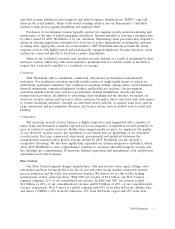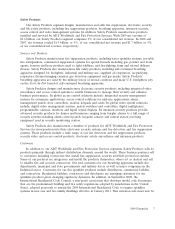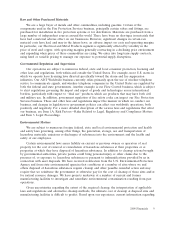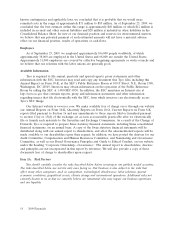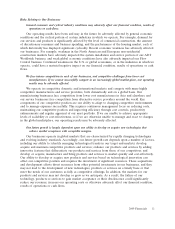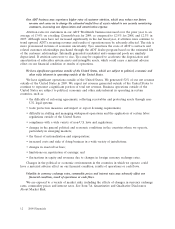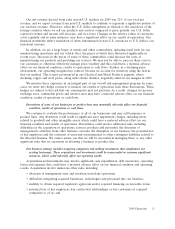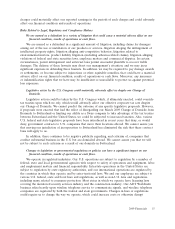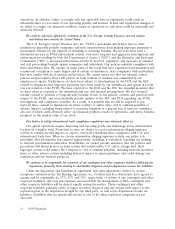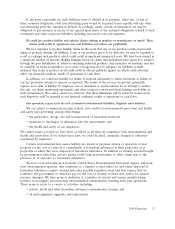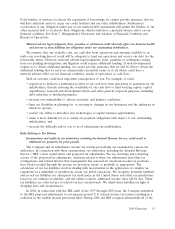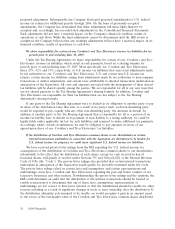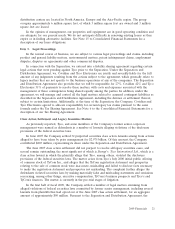ADT 2009 Annual Report Download - page 105
Download and view the complete annual report
Please find page 105 of the 2009 ADT annual report below. You can navigate through the pages in the report by either clicking on the pages listed below, or by using the keyword search tool below to find specific information within the annual report.Our net revenue derived from sales in non-U.S. markets for 2009 was 52% of our total net
revenue, and we expect revenue from non-U.S. markets to continue to represent a significant portion of
our total net revenue. Therefore, when the U.S. dollar strengthens in relation to the currencies of the
foreign countries where we sell our products and services compared to prior periods, our U.S. dollar
reported revenue and income will decrease, and vice-versa. Changes in the relative values of currencies
occur regularly and in some instances, may have a significant effect on our results of operations. Our
financial statements reflect translation of items denominated in non-U.S. currencies to U.S. dollars, our
functional currency.
In addition, we are a large buyer of metals and other commodities, including fossil fuels for our
manufacturing operations and our vehicle fleet, the prices of which have fluctuated significantly in
recent years. Increases in the prices of some of these commodities could increase the costs of
manufacturing our products and providing our services. We may not be able to pass on these costs to
our customers or otherwise effectively manage price volatility and this could have a material adverse
effect on our financial condition, results of operations or cash flows. Further, in a declining price
environment, our operating margins may contract because we account for inventory using the first-in,
first-out method. This is most pronounced in our Electrical and Metal Products segment, where
declining copper and steel prices, along with volume declines, negatively affected our margins in 2009.
We monitor these exposures as an integral part of our overall risk management program. In some
cases, we enter into hedge contracts to insulate our results of operations from these fluctuations. These
hedges are subject to the risk that our counterparty may not perform. As a result, changes in currency
exchange rates, commodity prices and interest rates may have a material adverse effect on our financial
condition, results of operations or cash flows.
Divestitures of some of our businesses or product lines may materially adversely affect our financial
condition, results of operations or cash flows.
We continue to evaluate the performance of all of our businesses and may sell businesses or
product lines. Any divestiture could result in significant asset impairment charges, including those
related to goodwill and other intangible assets, which could have a material adverse effect on our
financial condition and results of operations. Divestitures could involve additional risks, including
difficulties in the separation of operations, services, products and personnel, the diversion of
management’s attention from other business concerns, the disruption of our business, the potential loss
of key employees and the retention of uncertain environmental or other contingent liabilities related to
the divested business. We cannot assure you that we will be successful in managing these or any other
significant risks that we encounter in divesting a business or product line.
Our business strategy includes acquiring companies and making investments that complement our
existing businesses. These acquisitions and investments could be unsuccessful or consume significant
resources, which could adversely affect our operating results.
Acquisitions and investments may involve significant cash expenditures, debt incurrence, operating
losses and expenses that could have a material adverse effect on our financial condition and operating
results. Acquisitions involve numerous other risks, including:
• diversion of management time and attention from daily operations;
• difficulties integrating acquired businesses, technologies and personnel into our business;
• inability to obtain required regulatory approvals and/or required financing on favorable terms;
• potential loss of key employees, key contractual relationships, or key customers of acquired
companies or of us; and
2009 Financials 13


